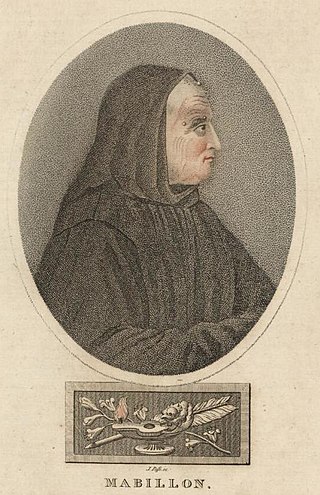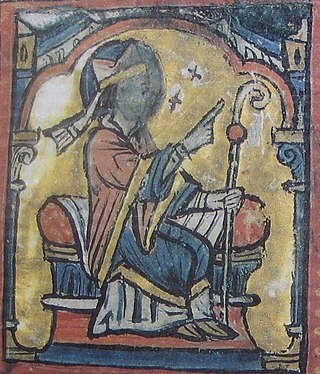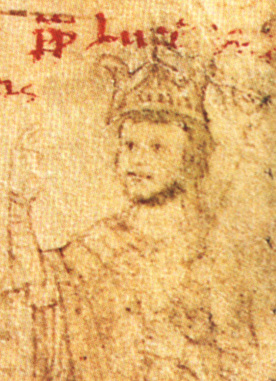Pope Alexander II, born Anselm of Baggio, was the head of the Roman Catholic Church and ruler of the Papal States from 1061 to his death in 1073. Born in Milan, Anselm was deeply involved in the Pataria reform movement. Elected according to the terms of his predecessor's bull, In nomine Domini, Anselm's was the first election by the cardinals without the participation of the people and minor clergy of Rome. He also authorized the Norman Conquest of England in 1066.
Diplomatics, or diplomatic, is a scholarly discipline centred on the critical analysis of documents: especially, historical documents. It focuses on the conventions, protocols and formulae that have been used by document creators, and uses these to increase understanding of the processes of document creation, of information transmission, and of the relationships between the facts which the documents purport to record and reality.

Dom Jean Mabillon, was a French Benedictine monk and scholar of the Congregation of Saint Maur. He is considered the founder of the disciplines of palaeography and diplomatics.
Liber diurnus Romanorum pontificum is the name given to a miscellaneous collection of ecclesiastical formulae used in the Papal chancery until about the 11th century. It fell into disuse through the changed circumstances of the times and was soon forgotten and lost.
Bullarium is a term commonly applied to a collection of papal bulls and other analogous documents, whether the scope of the collection be general in character, or limited to the bulls connected to any particular order, or institution, or locality.
Formularies are medieval collections of models for the execution of documents (acta), public or private; a space being left for the insertion of names, dates, and circumstances peculiar to each case. Their modern equivalent are forms.

Albinus was an Italian Cardinal of the late twelfth century. A native of Milan, or perhaps of Gaeta, he became an Augustinian regular canon.
Papal regesta are the copies, generally entered in special registry volumes, of the papal letters and official documents that are kept in the papal archives. The name is also used to indicate subsequent publications containing such documents, in chronological order, with summaries of their essential contents, for which the science of diplomatics - when written in English - usually uses the term "calendar".
Roman Historical Institutes are collegiate bodies established at Rome, for the purpose of historical research, mostly in the Vatican archives. These have been set both by ecclesiastical authority, and by national governments.

The December 1187 papal election was convoked after the death of Pope Gregory VIII. It resulted in the election of Cardinal Paolo Scolari, who took the name of Clement III.

The 1181 papal election followed the death of Pope Alexander III and resulted in the election of Pope Lucius III. This was the first papal election celebrated in accordance with the decree Licet de evitanda discordia, promulgated in the Third Lateran Council in 1179, which established that the pope is elected by a majority of two thirds votes.

Laborans de Pontormo was an Italian cardinal. His name in Italian is Laborante. He was a native of Pontormo, a suburb of the city of Florence on the left bank of the Arno River. He was a distinguished jurist and influential writer on canon law.

Radulfus Nigellus was a cardinal of the Roman Catholic Church. He was a native of Pisa, or perhaps of France.

Rolandus was a cardinal of the Roman Catholic Church. He was a native of Pisa, not Siena or Brittany. He was elected archbishop of Dol, but was not consecrated for five years, due to the opposition his metropolitan, the archbishop of Tours. Before he became a cardinal, he was sent by Pope Lucius III as his representative to Scotland to attempt to resolve a dispute over episcopal elections, involving the king.

Bobo was a cardinal of the Roman Catholic Church. He was a native of Rome, and a member of the Bobone family, later called the Orsini.

Graziano da Pisa was a cardinal of the Roman Catholic Church. He was a native of Pisa, and the nephew of Pope Eugenius III (1145-1153). He had studied law in Bologna, and held the rank of Magister. He was a prominent official in the papal chancery, and an accomplished papal diplomat.

Ardicio de Rivoltela was a cardinal of the Roman Catholic Church. He was a native of Piadena (Platina), in the diocese of Cremona in Lombardy. The appellation "de Rivoltela" is mentioned only once, and its significance is unclear.
Melior, O.S.B. Vall. was a Benedictine monk, and a cardinal of the Roman Catholic Church. He was a native of Pisa. He served as papal legate in France for more than three years, trying to arrange a peace between Richard I and Philip II. He became a major negotiator, on the mandate of Pope Celestine III, in the divorce case between King Philip II of France and Queen Ingeborg of Denmark.

Pietro de Bono was a cardinal of the Roman Catholic Church. He was a native of Verona in Lombardy, signing his name at least once as D. Petri de Verona. He was not from Pisa, nor was he from Bologna. He belonged to the Canons Regular of S. Maria di Reno in Bologna.



